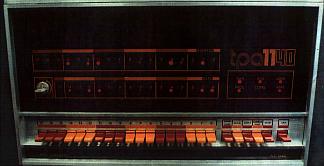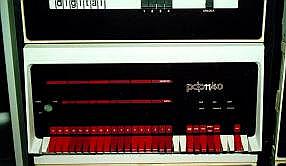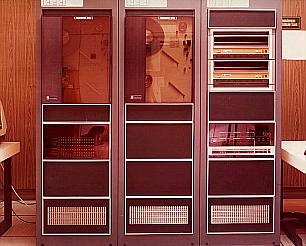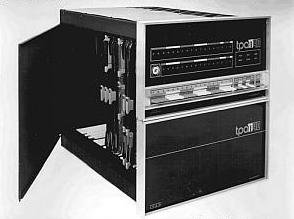"The TPA-1140 universal minicomputer is a high-performance member of the TPA (Stored-Program Analyser) computer-family developed by the Central Research Institute of Physics, Budapest. Due to its modern architecture and the software support that's outstanding in its category, it's best suited for laboratory and industrial process controlling as well as data-processing applications." (TPA-1140 Processor Handbook)
The TPA-1140 was a PDP-11
"clone" with everything the original Digital computers had: 16-bit words,
8-bit bytes, 8 general-purpose registers, multi-level interrupts, DMA and
a universal bidirectional asynchronous system interconnect, known as the
UBUS (which was hardware compatible with the original UNIBUS, it just had
different card-edge connectors).

The programmer's console of the KFKI TPA-1140 |

PDP-11/40 programmer's console |
Specifications:
- CPU, memory:
- Programmer's console:
- Expansion options:
The base configuration contained the microcoded SSI/MSI CPU (built with TTL ICs; with a cycle time of 1usec) and 8KW of RAM, and a real-time clock. The CPU was able to handle 28KW of RAM, but with the memory management option the maximum was 128KW. The memory was MOS or core.
Power key (ON/OFF/LOCK), address register display lights (18), data register display lights (16), switch register, status lights (RUN, PROCESSOR, BUS, CONSOLE, USER, VIRTUAL), control switches (LOAD ADRS, EXAM, CONT, ENABLE/HALT, START, DEP)
Extended fixed-point arithmetical unit, fixed-point arithmetical unit, memory management.

Mechanical specs:
- Frame:
- Drawers:
- UBUS cards:
Standard 19" wide, 36U high rack with own power supply unit. One frame contained two 12U-high drawer for the system components.
Each drawer contained seven 4 card-high or three 9 card-high UBUS adaptor. These were connected via jumper cables or terminated with the appropriate terminators.
There were three different card-dimensions: single, dual and triple. As you can see, the connecting "fingers" of the cards are different from UNIBUS-cards. The UBUS could be connected to the UNIBUS with a simple jumper cable.
- Disk units on the NR5501 controller (the equivalent of the RK11):
- Fixed-head disk drives on the NR646/1140 interface unit:
- Tape drives on the NR5502 (Digital TM11):
- Floppy drives on the NR5504 (DEC RX01)
- Card puncher/readers on the NR5601 (DEC CR11) controller:
- Papertape reader/punchers on the NR5802 (DEC PT11) controller:
- Printers on the NR5701 interface (DEC LP11):
- Hardcopy and CRT terminals, printers on the NR5801 (DEC DL11) controller:
- Synchronous terminals, line adapters on the NR5803 interface (DEC DU11)
- Converters, custom peripherals, measurement units
CM5400 hard disk, 3 MB on a removable disk-cartridge and 3 MB on a non-removable platter
1500 RPM, 15 msec track-to-track seek time, 50 msec average seek time
DRI MOD 312 3 MB removable disk catridge
1500 RPM, 15 msec track-to-track seek, 70 msec average seek time
MOM DM256-1/W
256 KW, 3000 RPM
Digidata 1739-1 800/1600 bpi 9-track .5" tape drive with 36-72 KB/sec throughput
EC5012-01, EC5017-02 9-track, .5" tape drive, 16-64 KB/sec (these units were designed for the IBM-clones of the Centralized Computersystem Project of the socialist countries)
Videoton VT42110 600 cards/min
CT2xxx (300-2000 cps)
MOM EM300
DZM180 (LX180 licence) matrix-dot printer, 180 cps
Videoton VT24110 (DP 2310-license) line printer, 356/650 lps
Videoton VT25110/25150 (DP2410-license) line printer, 245-1110 lps
KFKI TDP-05 CRT terminal, 75-2400 bps, 20x80 display
Videoton VT340 1200 bps, 16x80 display
ASR33 Teletype
- LOS - Paper-tape Operating System (PTOS)
- DOS-RV - Real-time Multiprogramming System (RSX-11)
- DOS-RV-Plus (RSX-11M+)
- MOS-RV (RSX-11S)
- FOBOS - Single-user Program Development System (RT-11)
Paper-tape based OS with BASIC and assembly development enviroment
For program-development and controlling of multiple processes
A small disk-based OS for program-development and real-time process control, with MACRO, BASIC and FORTRAN
